 Here’s a reader question on international equities that reflects some of what I’ve been reading elsewhere and thinking about in my head:
Here’s a reader question on international equities that reflects some of what I’ve been reading elsewhere and thinking about in my head:
I was doing my mid-year rebalance and noticed that international equity funds did terrible over the past 10 years, I have a fair amount of money in international equities, as do you. I’m considering lowering the % because they generally under perform US funds. Would love your thoughts.
First, let’s look back at some history (i.e. my old posts). Is it really true that US stocks historically perform better than International stocks? Also, the diversification benefit comes from the very fact that these asset classes don’t always move in sync (not perfectly correlated), allowing you to attain a higher risk-adjusted return by holding some of both as opposed to just one or the other.
From 1970-2006, foreign stocks outperformed US stocks, while the point of optimal risk-adjusted returns was a split of 76% US and 24% Foreign Developed (EAFE) (70% is a typo). The chart is taken from a past edition of A Random Walk Down Wall Street by Burton Malkiel.
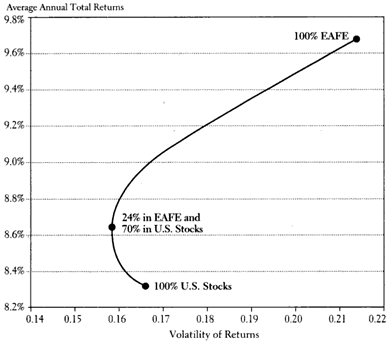
From 1970-2013, the same chart shows that US stocks now outperformed foreign stocks on average, with the point of optimal risk-adjusted returns at 70% US and 30% Foreign Developed. From Rick Ferri:
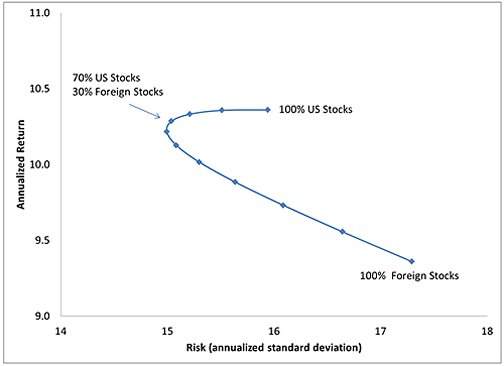
From 1970 to 2015, the average annualized return of the S&P 500 has been 10.3%, while MSCI Europe has returned 10.0%. Sometimes US wins. Sometimes International wins. Here’s a chart from Ben Carlson of A Wealth of Common Sense showing the rolling 5 year over- and underperformance of U.S. stocks relative to European markets (MSCI Europe):
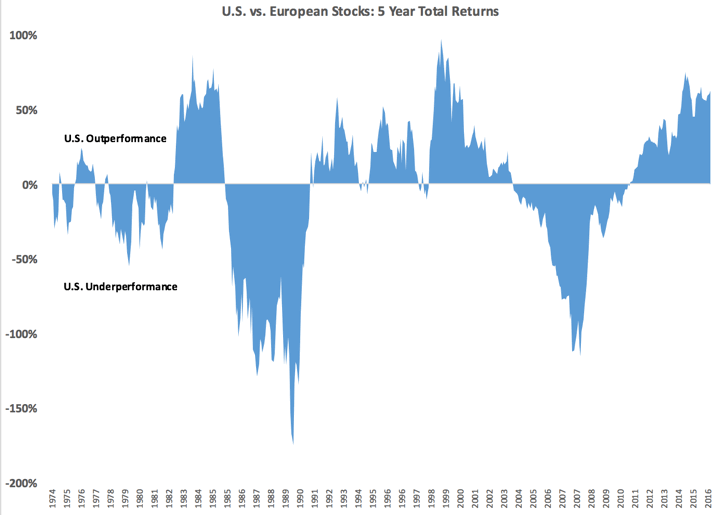
This is an example of why “staying the course” sounds easy but it isn’t in real life. On one hand, some of the recent doubt about Europe and Emerging Markets has to be about performance chasing. Look at the recent divergence in two major mutual funds that track Total US (VTSAX) and Total International (VTIAX) indexes, taken from Morningstar. This shows the growth of $10,000 invested 5 years ago:
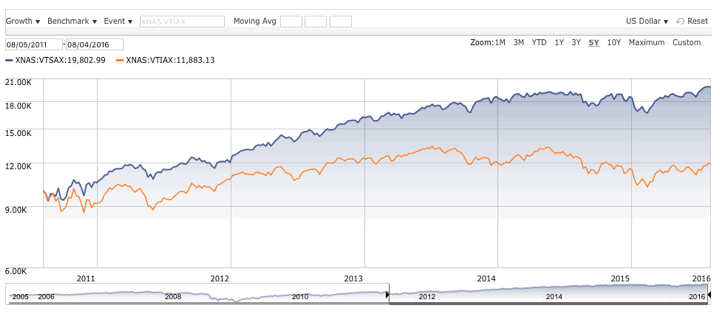
On the other hand, there are real reasons behind the performance difference. The US economy has been more resilient and the future does look more bright. Europe and Emerging markets have more obvious problems without a visible solution. But that also means that US stocks are more richly valued, and International stocks are “cheaper”. Every model that uses historical data shows that International stocks have a higher future expected return. Here is Research Affiliates as one example:
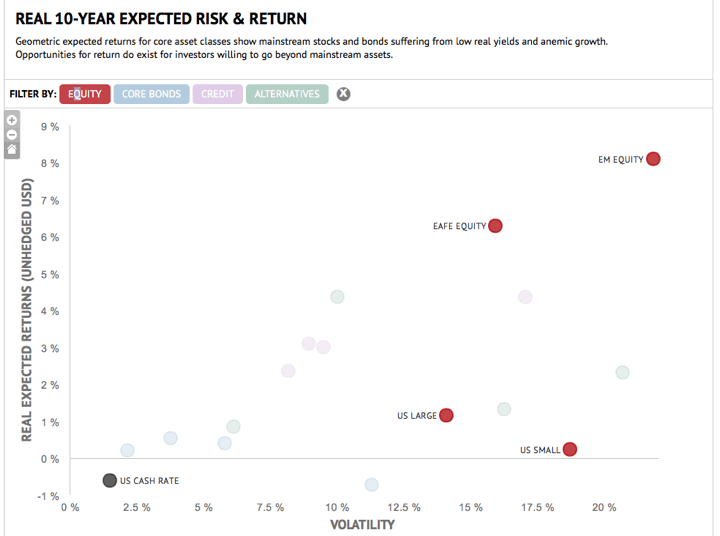
Summary. The formal advice is that you should have a written “investment policy statement” (IPS) that states why you hold your current asset allocation in the first place. In other words, what where the reasons behind your current allocation? Have they changed? For me, nothing has really changed about why I bought both US and international stocks in the first place. Their long-term historical returns remain similar, and while the US may be slightly ahead at this moment, this could easily change again in the next decade.
It’s not fun to hold these international stocks right now, but I focus on the fact that European and Emerging Markets valuations are relatively cheaper and the dividend payout rates are relatively higher. By owning a globally-diversified passive portfolio, I choose to rely on the markets to work themselves out over time.
 The Best Credit Card Bonus Offers – 2025
The Best Credit Card Bonus Offers – 2025 Big List of Free Stocks from Brokerage Apps
Big List of Free Stocks from Brokerage Apps Best Interest Rates on Cash - 2025
Best Interest Rates on Cash - 2025 Free Credit Scores x 3 + Free Credit Monitoring
Free Credit Scores x 3 + Free Credit Monitoring Best No Fee 0% APR Balance Transfer Offers
Best No Fee 0% APR Balance Transfer Offers Little-Known Cellular Data Plans That Can Save Big Money
Little-Known Cellular Data Plans That Can Save Big Money How To Haggle Your Cable or Direct TV Bill
How To Haggle Your Cable or Direct TV Bill Big List of Free Consumer Data Reports (Credit, Rent, Work)
Big List of Free Consumer Data Reports (Credit, Rent, Work)
I realized that international stocks have done worse relative to the US over the past 10 years. If you look at VGTSX, international has done worse than VFINX/VTSAX over the past 20 years as well. This is a long period of time – but that doesn’t really tell us what the next 10 – 20 years will be.
I think that the Europe fund VEUSX has done fine relative to the US since 1990.. But the Pacific fund VPACX has been flat for 26 years..This is probably due to the Japanese bubble bursting in 1990.
That being said, readers should not focus on past performance, and assume it is indicative of future returns. By the time you start reading about how terrible international stocks are, it is very likely that you need to consider initiating or increasing your exposure there.
Average returns are not a good measure. You have to look at your max drawdown to understand the real risk to your portfolio.
got a nice typo in bold in the first paragraph: Is is really true that US stocks historically perform better than International stocks?
Haha, thanks.
Hi Jonathan,
Thanks for “talking me down”. Its tough to keep perspective with such a long term Investment horizon. Your analysis goes back to 1970! But i completely agree, we should look long term.
Also, recent performance in all asset classes have been skewed by the Fed’s monetary policy. Long term, we’ll reach equilibrium with historical norms.
Cogent analysis. Thanks Jonathan!
How often do you rebalance your portfolio?
I rebalance whenever I have new money being invested throughout the year. I try to avoid sell transactions if possible, but if needed then I do that once a year.